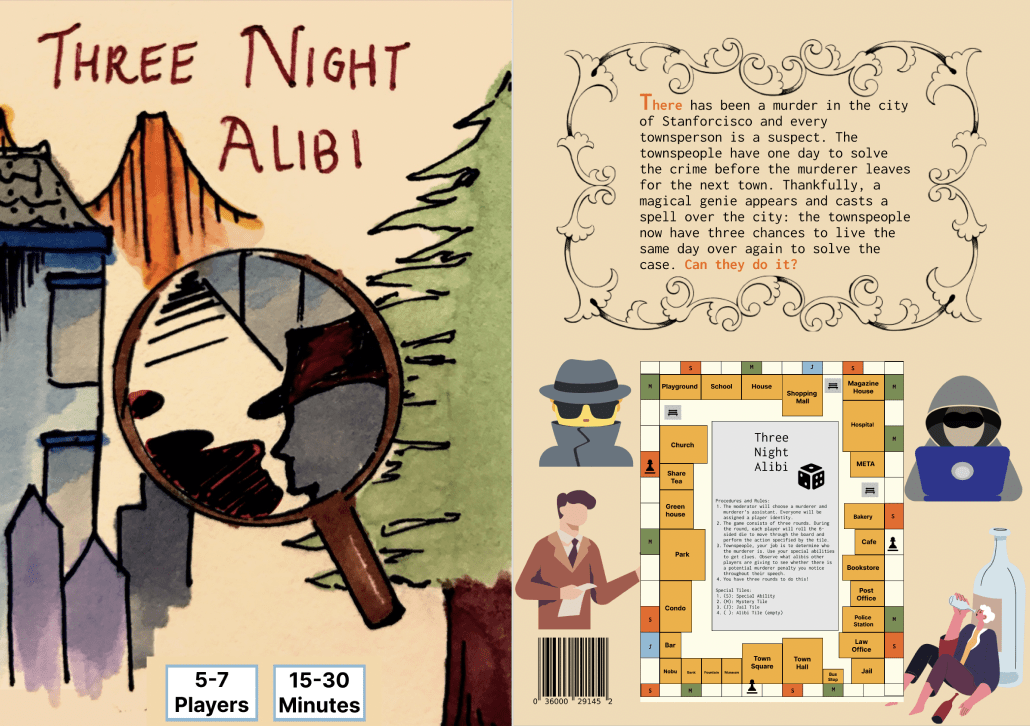Artist’s Statement
Three Night Alibi is a role-playing murder mystery board game designed for small groups of friends. Our goal is to empower players to explore both their role-playing and social deception skills while working together to solve an exciting murder mystery. Think Mafia meets Clue meets Robot Interrogation.
In the game, there has been a murder in the city of Stanforcisco and every townsperson is a suspect. Thankfully, a magic genie casts a spell, and the townspeople now have three chances to relive the same day. Immerse into your role as the town Detective or Lawyer (or even the town Paparazzo or Alcoholic—yes, that’s right!), argue your own alibis, and search for clues left at the crime scene and by the murderer themself. By blending the challenge of fellowship with the entertainment of narrative, Three Night Alibi creates an experience for friends that is uniquely deductive, humorous, and immersive.
Concept Map (Game Mechanics and Interaction of Players):
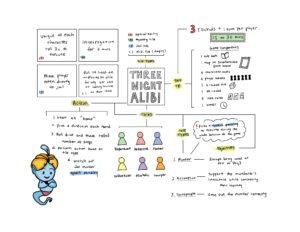
Ideation Exploration
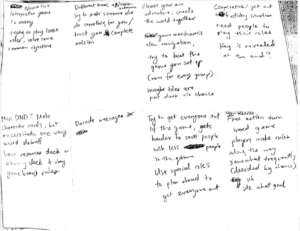
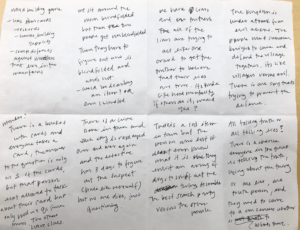
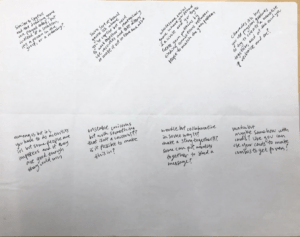
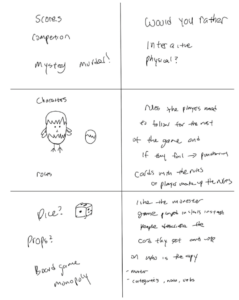
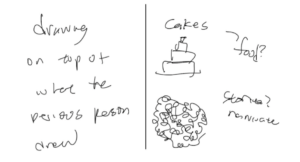
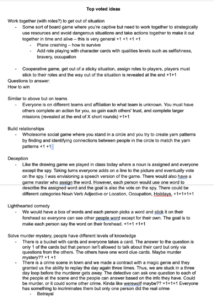
Initial Decisions about the Formal Elements and Values
We designed our game with the Formal Elements guiding our intended aesthetics of fun. Here is a discussion of our initial decisions for the Formal Elements which we laid out for the first prototype, which was solely a card game (no board).
- Players: Minimum of 5 players including 1 moderator. We chose this number of players so that the murder mystery would be a comprehensive enough story experience. The player dynamic is unilateral competition (for the Murderer) and multilateral (for everyone else, the townspeople).
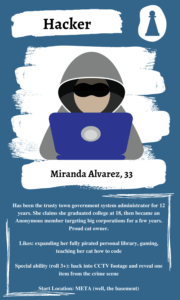
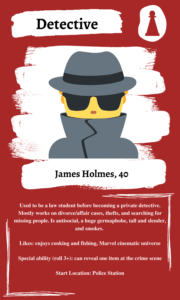
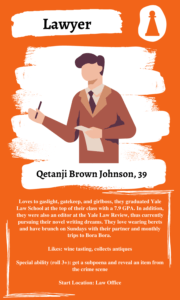
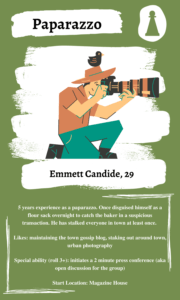

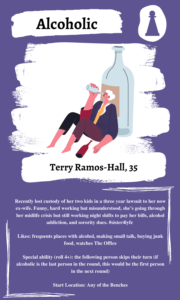
- Objectives: The objective of the townspeople is to gather clues to identify which player is the Murderer by the end of the game. The objective of the Murderer is to conceal their identity throughout the game. This element draws from the Objectives of Mafia and Werewolf.
- Outcomes: The outcome is zero-sum: either the Murderer wins or the townspeople win. At the end of the game, the players will vote on who they believe is the spy. If the townspeople successfully identify the Murderer, the townspeople win. If the townspeople are unable to correctly identify the murderer, the Murderer wins. This element draws from the Outcomes of Mafia and Werewolf, which are also social deception games.
- Procedures and Rules: Please see our rulebook (Link to Rulebook) for a complete manual of procedures and rules. Please note that these rules have been iterated based on our several rounds of playtesting.
- Resources: The game will provide players with a set of cards for characters, times, locations, and items. The deck of characters is profiles that the players will be assigned to role-play, and these character cards also include the special abilities that players can use to get clues. The deck of times and the deck of locations will become alibis that players must argue upon drawing randomly. The deck of items is items left at the crime scene that some players can use their special abilities to reveal, and these will serve as clues to help the townspeople identify the suspect.
- Boundaries: The physical boundaries are the table space—as this is a card game, the players should be situated near each other, ideally in an oval. The narrative boundaries are the scope of our character profiles (age, occupation, hobbies, etc.) and the town where the murder took place and they live; this allows players to exercise their creative liberty while making the story coherent.
- Values: Our game has the core aesthetics of Fellowship and Narrative. For Fellowship, our game challenges the murderer to succeed in deceiving their fellow players and the players to deduce who the murderer is in the group. There is also Collaboration between the players, to work together and find clues to solve the murder mystery. For Narrative, players receive engaging characters to roleplay, and they use these roles to craft imaginative narratives as they try to convince everyone else of their alibis.
Testing and Iteration History
- Playtest 1: Card game Version – In Class (with Jen and Peng, and their third teammate)
- Players: 1 Notetaker, 1 Moderator, 5 Players
- What went well:
- Creating the narrative/alibi was the most fun component of the game
- What didn’t go well:
- There was no point in the debate rounds if the special ability round was going to reveal the murderer
- Playtesters didn’t understand the narrative/alibi round; the game didn’t seem cohesive overall with all the parts
- The alcoholic’s special ability completely nullified all abilities for the round, which the playtesters felt was too dramatic
- The map was confusing, wasn’t clear how it all connected
- Items revealed at the crime scene were too obvious to solving the mystery
- Didn’t like voting people off every round, especially the first round when there wasn’t even enough information
- Suggestions for the next iteration:
- Impose more constraints on the murderer
- Let the beginning of each round be a time to reveal information about the character each person was roleplaying
- Playtest 2: Board game I – Game Night (with TAs and a fellow 247G student)
- Players: 1 Notetaker, 1 Moderator, 4 Players
- What went well:
- Board game medium allowed players to feel more agency (as compared to card game)
- Locations on the board were funny, made people laugh and made the game feel humorous
- What didn’t go well:
- Board play was confusing and it was very easy to manipulate your path
- The murder killing method and time were not used in the alibi by any of the players → do not need the murder method deck of cards
- Too much pressure on the genie to make up the special ability (follow the murderer’s path) for the paparazzo → the murder path the genie conceives would be very arbitrary
- Suggestions for the next iteration:
- Set constraints on board movement: limit the player’s direction per round, prohibit retracing steps
- Integrate some additional game component to insert some functionality into the alibi aspect of the game (for instance, insert a backstory that is only revealed to one player, include an additional role that coordinates with the murderer, include a Spyfall-esque element)
- Playtest 3: Board game II – In Class (with Eugene, Connor, and Zakaria)
- Players: 1 Notetaker, 1 Moderator, 5 Players
- What went well:
- Really enjoyed the alibi part of the game where they could make up stories and be creative
- What didn’t go well:
- The alibi part did not play a role in solving the murder at all, so there was a disconnect
- The murderer became obvious from all the info the townspeople received throughout the game
- Items were too distinct so it was easy to deduce the suspect
- Suggestions for the next iteration:
- Have a third die to reveal items related to the murder
- Define the murderer more (for instance, pose limitations on them, like keywords they must use, etc.)
- Make the murderer not so obvious, perhaps by limiting the number of special ability tiles on the board
- To help the murderer, introduce a murderer’s accomplice to throw off the game
- Include more diverse action tiles on the board to make the gameplay more interesting
- Playtest 4: Board game III – In Class (with Rick, Neha, and Francesca)
- Players: 1 Notetaker, 1 Moderator, 5 Players
- What went well:
- The alibi aspect of the game was what made the game funny
- Using the 24-sided die to determine time was very clever and made it efficient
- Special action tiles felt balanced with the normal, alibi tiles
- What didn’t go well:
- It was difficult to figure out the murderer in three rounds (likewise, there was only one item that directly hinted at the murder)
- The moderator role felt boring and the moderator guide was not very clear
- The murder items weren’t as obvious as well, and the movement of the game pieces was also a bit confusing while traversing the board.
- Suggestions for the next iteration:
- To help the townspeople, increase the probability to activate the special abilities and enforce more penalties on the murderer
- To help the murderer, make the items less obvious
- Make the rulebook/moderator guide clear by reordering the information around, and to address the boring aspect, incorporate more tasks for the moderator to do
- Create some sort of cheat sheet for the players so they can have the most important rules at hand
- Aside: We also received a comment from one of the playtesters that this was the most fun game that they had playtested so far 🙂
- Playtest 5: Board game IV – At dorm (with Ricky, John, Michael, and Constance)
- Players: 1 Moderator, 5 Players
- What went well:
- Was a group of close friends, which made for comfortable role-playing
- Everyone was invested into their roles
- Was able to incorporate alibis with the player token locations on the board (the paparazzo was stalking the alcoholic)
- We successfully overcame the problem of the alibi not being significant to solving the mystery
- What didn’t go well:
- Complicated rules for first-time players (took a long time to set up and explain)
- The murder assistant had no incentive to use their special ability (item reveal)
- Suggestions for the next iteration:
- Have the moderator show the person executing the special ability the item so the murder assistant can lie about the item
Link to Embedding of the Final Prototype
- Final Prototype: Link to Final Prototype
Rules and Other Components
- Link to the Rulebook / Moderator Guide: Link to Guide
Video of the Final Playtest
- Link to the Final Playtest video: Link to Video
Link to or embedding of design mockups
- Figma Link to Map Iterations: Link to Iterations
- Printable Version: Final Map
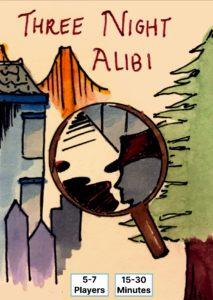

Three Night Alibi by Ji Hong Ni, Kathleen Yuan, Cathy Zhang, Jialin Zhuo


